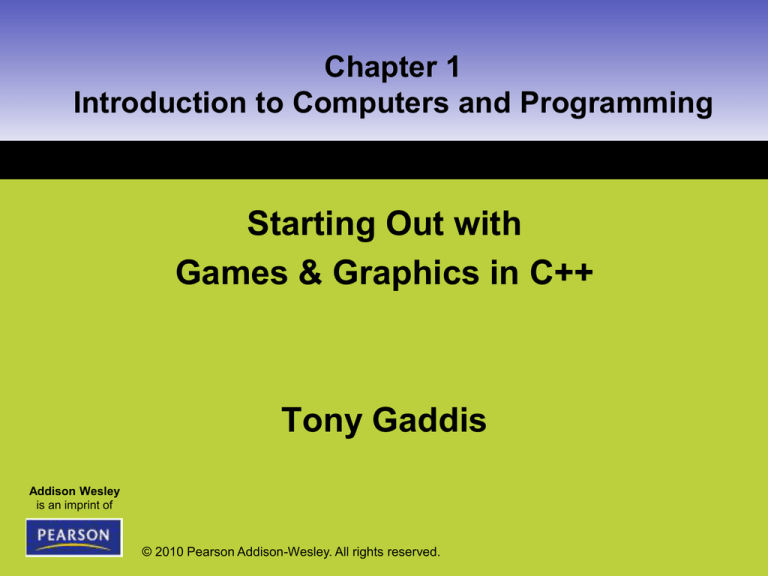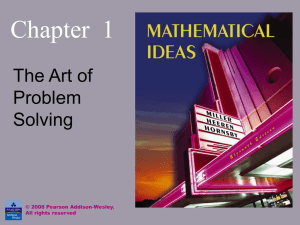
Chapter 1
Introduction to Computers and Programming
Starting Out with
Games & Graphics in C++
Tony Gaddis
Addison Wesley
is an imprint of
© 2010 Pearson Addison-Wesley. All rights reserved.
1.1 Introduction
• A program is a set of instructions that a
computer follows to perform a task.
• Programs are commonly referred to as
software.
What software have you used?
Copyright © 2010 Pearson Addison-Wesley
1-2
1.1 Introduction
• Programmers or Software Developers are the
individuals that create computer software.
• They have the training and skill to design,
create, and test computer programs.
What are some of the fields in
which computer programs are
used?
Copyright © 2010 Pearson Addison-Wesley
1-3
1.2 Hardware
Concept:
The physical devices that a computer
is made of are referred to as the
computer’s hardware. Most computer
systems are made of similar
hardware.
Copyright © 2010 Pearson Addison-Wesley
1-4
1.2 Hardware
• The physical devices that a computer is
made of are referred to as the computer’s
hardware.
• A computer is a system of devices that
work together.
Copyright © 2010 Pearson Addison-Wesley
1-5
1.2 Hardware
A Computer System consists of:
–
–
–
–
–
Central Processing Unit (CPU)
Main memory
Secondary storage
Input devices
Output devices
Figure 1-1 Typical components
of a computer system
Copyright © 2010 Pearson Addison-Wesley
1-6
1.2 Hardware
Central Processing Unit (CPU)
The CPU is the part of a computer that runs the
programs.
Without a CPU a computer cannot run software.
Running or executing a program is the term used when the
computer performs the tasks that the program tells it to do.
Copyright © 2010 Pearson Addison-Wesley
1-7
1.2 Hardware
Figure 1-2 The ENIAC computer
(courtesy of U.S. Army Historic Computer Images)
ENIAC
• World’s first programmable
computer
• Built in 1945
• Designed to calculate artillery
ballistic tables for the U.S. Army
• CPU was 8 feet tall, 100 feet
long, and weighed 30 tons
Microprocessor
• Much smaller
• Much more powerful
Copyright © 2010 Pearson Addison-Wesley
Figure 1-3
A lab technician
holds a modern
microprocessor (photo
courtesy of Intel
Corporation)
1-8
1.2 Hardware
Main Memory
• Considered the computer’s work area
• Stores the program that is running as well as the data
•
•
•
•
•
Commonly known as the random-access memory (RAM)
Data is quickly accessed
RAM is a volatile type of memory
Used for temporary storage
RAM is erased when computer is turned off
Copyright © 2010 Pearson Addison-Wesley
1-9
1.2 Hardware
Secondary Storage Devices
• Type of memory that can hold data for long periods of time.
• Programs and important data are stored in secondary storage
• Disk drive is a common type of secondary storage
– Data is stored by magnetically encoding it onto a circular
disk
– Most computers have an internal disk drive
– Some have external disk drives; they are used to create backup
copies
• Floppy drives record data onto a small floppy disk
– Holds only a small amount of data
– Slow to access data
– Can be unreliable
– Are becoming obsolete
Copyright © 2010 Pearson Addison-Wesley
1-10
1.2 Hardware
Secondary Storage Devices
• USB drives are small devices that plug into the computer’s
universal serial bus (USB) port
– It does not contain a disk
– The data is stored on flash memory
– Also known as memory sticks and flash drives
– Inexpensive, reliable, and small
• Optical devices (CD or DVD)
–
–
–
–
Data is encoded as a series of pits on the disc’s surface
Uses laser to encode the data
Holds large amounts of data
Good medium for creating backups
Copyright © 2010 Pearson Addison-Wesley
1-11
1.2 Hardware
Input Devices
• Any data the computer collects from people and from other
devices is called input.
• The hardware component that collects the data is called an input
device.
• Common input devices are:
–
–
–
–
–
Keyboard
Mouse
Scanner
Microphone
Digital camera
Can you think of any other input
devices?
Copyright © 2010 Pearson Addison-Wesley
1-12
1.2 Hardware
Output Devices
• Any data the computer produces for people or for other devices is
called output.
• The hardware component that formats and presents the data is
called an output device.
• Common output devices are:
– Monitor
– Printer
Can you think of any other output
devices?
Copyright © 2010 Pearson Addison-Wesley
1-13
1.3 How Computers Store Data
Concept:
All data that is stored in a computer is
converted to sequences of 0’s and
1’s.
Copyright © 2010 Pearson Addison-Wesley
1-14
1.3 How Computers Store Data
• A computer’s memory is divided into tiny storage locations
known as bytes
• One byte represents one number
• A byte is divided into eight smaller storage locations
known as bits (binary digits)
• Bits are tiny electrical components that can hold either a
positive or a negative charge.
• A positive charge is similar to a switch in the on position
• A negative charge is similar to a switch in the off position
Figure 1-5 Think of a byte as eight
switches
Copyright © 2010 Pearson Addison-Wesley
1-15
1.3 How Computers Store Data
Storing Numbers
• The positive charge or the on position is represented by
the digit 1
• The negative charge or the off position is represented by
the digit 0
• This corresponds to the binary numbering system where
all numeric values are written as a sequence of 0s and
1s
• Each digit in a binary number has a value assigned to it
Figure 1-7 The values of binary
digits as powers of 2
Copyright © 2010 Pearson Addison-Wesley
1-16
1.3 How Computers Store Data
Storing Numbers
For example:
Figure 1-9 Determining the value of
10011101
Copyright © 2010 Pearson Addison-Wesley
Figure 1-10 The bit pattern for 157
1-17
1.3 How Computers Store Data
Storing Numbers
• The largest value that can be stored in a byte with
eight bits is 255
• Two bytes are used for larger numbers; maximum
value is 65535
Figure 1-11 Two bytes used for a large number
Copyright © 2010 Pearson Addison-Wesley
1-18
1.3 How Computers Store Data
Storing Characters
• Characters are stored in the computer’s memory as
binary numbers
• ASCII (American Standard Code for Information
Interchange) is a coding scheme
Figure 1-12 The letter A is stored in memory as the number 65
Copyright © 2010 Pearson Addison-Wesley
1-19
1.3 How Computers Store Data
Storing Characters
• ASCII is a set of 128 numeric codes
• ASCII is limited
• Unicode is an extensive encoding scheme
• It is compatible with ASCII
• It represents characters for many languages in the
world
Copyright © 2010 Pearson Addison-Wesley
1-20
1.3 How Computers Store Data
Negative Integers
• Binary numbering system can be used to represent only
integer numbers, beginning with 0.
• Negative numbers are encoded using two’s complement
Real Numbers
• Binary numbering system can be used to represent only
integer numbers, without a fractional part.
• Real numbers are encoded using floating-point notation
Copyright © 2010 Pearson Addison-Wesley
1-21
Other Types of Data
• Digital data is data that is stored in binary
• A digital device is any device that works with binary data
• Digital images are composed of tiny dots of color known
as pixels (picture elements)
• Digital sound is broken into small pieces known as
samples
Copyright © 2010 Pearson Addison-Wesley
1-22
1.4 How a Program Works
Concept:
A computer’s CPU only understands
instructions that are written in
machine language. Because people
find it very difficult to write entire
programs in machine language, other
programming languages have been
invented.
Copyright © 2010 Pearson Addison-Wesley
1-23
1.4 How a Program Works
•
•
•
•
CPU is the most important component in a computer
CPU is not a brain
CPU is not smart
CPU is an electronic device that is designed to do specific
things.
Copyright © 2010 Pearson Addison-Wesley
1-24
1.4 How a Program Works
CPU is designed to perform the following operations:
• Read a piece of data from main memory
• Adding two numbers
• Subtracting one number from another number
• Multiplying two numbers
• Dividing one number by another number
• Moving a piece of data from one memory location to
another
• Determining whether one value is equal to another
value
Copyright © 2010 Pearson Addison-Wesley
1-25
1.4 How a Program Works
• CPU only understands instructions written in machine
language
• Machine language instructions are written in 1s and 0s
• The entire set of instructions that a CPU can execute is
known as the CPU’s instruction set
• Each brand of microprocessors (Intel, AMD, and Motorola)
has a unique instruction set
Copyright © 2010 Pearson Addison-Wesley
1-26
1.4 How a Program Works
• Fetch-decode-execute cycle is the term used when the
CPU executes the instructions in a program.
• The cycle consist of three steps:
– Fetch
– Decode
– Execute
Figure 1-15 The fetch-decodeexecute cycle
Copyright © 2010 Pearson Addison-Wesley
1-27
1.4 How a Program Works
From Machine Language to Assembly
Language
•Computers only understand machine language
•Machine language is difficult to write
•Assembly language uses short words that are known as
mnemonics
•Assembler is used to translate an assembly language
program to machine language
Figure 1-16 An assembler
translates an assembly
language program to a
machine language program
Copyright © 2010 Pearson Addison-Wesley
1-28
1.4 How a Program Works
High-Level Languages
•Assembly language is referred to as a low-level language
•High-level languages allow you to create powerful and
complex programs without knowing how the CPU works, using
words that are easy to understand.
For example:
Ada, BASIC, Python, C++, Ruby, Visual Basic
Do you know of any other highlevel computer programming
languages?
Copyright © 2010 Pearson Addison-Wesley
1-29
1.4 How a Program Works
Key Words, Operators, and Syntax: an
Overview
• Key words or reserved words have specific meaning and
purpose in the programming language
• Operators perform various operations on data
• Syntax is a set of rules that must be strictly followed when
writing a program
• Statements are individual instructions written in a
programming language
Copyright © 2010 Pearson Addison-Wesley
1-30
1.4 How a Program Works
Compilers and Interpreters
•The statements written in a high-level language are called
source code or simply code
•Source code is translated to machine language using a
compiler or an interpreter
•A Syntax error is a mistake such as a:
• Misspelled word
• Missing punctuation character
• Incorrect use of an operator
Copyright © 2010 Pearson Addison-Wesley
1-31
1.4 How a Program Works
Compilers and Interpreters
•A Compiler is a program that translates a high-level language
program into a separate machine language program
Figure 1-17 Compiling a high-level program and executing it
• The C++ language uses a compiler
Copyright © 2010 Pearson Addison-Wesley
1-32
1.4 How a Program Works
Compilers and Interpreters
•An interpreter is a program that both translates and executes
the instructions in a high-level language program
Copyright © 2010 Pearson Addison-Wesley
1-33
1.5 C++ and the Dark GDK Library
Concept:
C++ is a high-level programming
language, and the Dark GDK is a
library of prewritten code that can be
used in C++ to write games and
graphical programs.
Copyright © 2010 Pearson Addison-Wesley
1-34
1.5 C++ and the Dark GDK Library
• C++ is one of the most popular programming languages.
• C++ is used by professional programmers
• C++ is widely used by game developers
Copyright © 2010 Pearson Addison-Wesley
1-35
1.5 C++ and the Dark GDK Library
• C++ was based on the C programming language
• C was created in 1972 by Dennis Ritchie at Bell
Laboratories for writing system software.
• System software controls the operation of a computer.
For example, an operating system like:
Windows, Linux, or Mac OS X
• System software must be efficient and fast.
• C was designed as a high performance language.
Copyright © 2010 Pearson Addison-Wesley
1-36
1.5 C++ and the Dark GDK Library
• C++ was created by Bjarne Stroustrup at Bell
Laboratories in the early 1980’s.
• C++ is an extension of the C language.
• C++ retains the speed and efficiency of C, and
adds numerous modern features.
• C++ is favored by game programmers because of
its speed and efficiency.
Copyright © 2010 Pearson Addison-Wesley
1-37
1.5 C++ and the Dark GDK Library
• C++ does not have built-in features for writing
graphical programs or games.
• We use the Dark GDK library for this reason.
• A library is a collection of code that has already
been written for some purpose.
• The Dark GDK library can be used with C++ for
handling graphics and writing game programs.
Copyright © 2010 Pearson Addison-Wesley
1-38
1.5 C++ and the Dark GDK Library
• The Dark GDK library was developed by The
Game Creators.
• The Game Creators is a software company based
in the United Kingdom.
• GDK stands for Game Development Kit.
• We will sometimes refer to the Dark GDK library
simply as the Dark GDK.
Copyright © 2010 Pearson Addison-Wesley
1-39
1.5 C++ and the Dark GDK Library
The Software You Will Need
•
You will need to install the following software and files:
• Microsoft Visual C++ 2008
– Comes with the book, if purchased new
– Can be downloaded from Microsoft’s website
• The Dark GDK
– Must be downloaded from The Game Creators Web site
• Sample Source Code and Media Files
– Can be downloaded from the publisher’s Web site
• See Appendix A for instructions
Copyright © 2010 Pearson Addison-Wesley
1-40
Chapter 1
Introduction to Computers and Programming
QUESTIONS
Addison Wesley
is an imprint of
?
© 2010 Pearson Addison-Wesley. All rights reserved.







